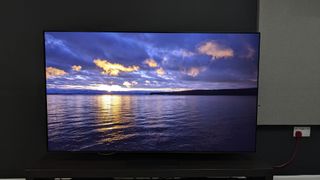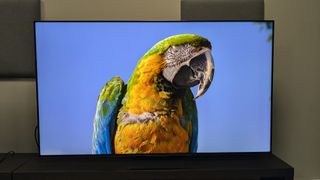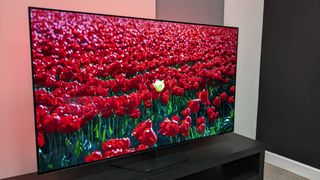This year has seen incredible advances in the TV world, with refinements to OLED and mini-LED tech serving to enhance the newest crop of sets. OLED still arguably reigns supreme in 2024, but mini-LED is catching up fast, leveling the field on what models earn the title of best TV.
Highlights so far have included Sony’s decision to move from OLED to mini-LED for its flagship TV, the brilliant Sony Bravia 9, which utilizes its new XR Backlight Master Drive tech (with 22-bit LED drivers) to deliver more refined local dimming. We’ve also seen Samsung, LG and Philips claim their OLED TVs can hit a peak brightness of over 3,000 nits – something we’ve yet to confirm in our testing – and measured over 1,000 nits peak brightness on mid-range OLEDs such as the LG C4 for the first time.
Micro lens array (MLA) tech has entered its second generation, being utilized to maximum effect in OLED TVs such as LG G4. Meanwhile, QD-OLED has hit its third generation, and is used in one of the best OLED TVs this year, the Samsung S95D (spoiler: this isn’t the last you’ll hear of this TV). Even mini-LED has evolved outside of Sony’s Bravia 9, with TVs from brands like TCL hitting an eye-watering 6,500 nits.
Of the TVs I’ve reviewed this year, from the most premium OLED to budget QLED models, several have stood out among the crowd. Here are the top three TVs I’ve reviewed in 2024.
1. Samsung S95D

The Samsung S95D is one of the best OLED TVs I’ve ever seen. In my review, I described it as “the standard bearer for OLED in 2024”. Using QD-OLED tech (a combination of an OLED panel with QLED tech for added brightness and color richness), the S95D delivers spectacular contrast, dazzling HDR highlights and bold colors. Its NQ4 AI Gen2 processor also lets it deliver incredibly well-defined and realistic textures and details.
The S95D’s main secret weapon is its OLED Glare Free screen. This anti-reflection tech uses a matte screen and anti-glare coating to effectively eliminate reflections – arguably one of OLED’s biggest issues. I described this OLED Glare Free screen as “the star of the show” in my review, as I found that I could even watch the dark and challenging images in The Batman in bright viewing conditions – something other OLED TVs I’d tested have struggled with.
But, it’s not just picture where the S95D shines, as it’s also a well-equipped gaming TV with an ultra-low 8.9ms input lag and four HDMI 2.1 ports supporting 4K 144Hz, VRR (with AMD FreeSync Premium Pro in tow) and ALLM. Combine that with its picture and you have one of the best gaming TVs around.
The S95D also looks fantastic, with a ‘floating’ design thanks to its stand and razor-thin depth. As a bonus, its built-in sound is good too, with controlled bass, good placement of effects, and brilliant directional sound. It’s no doubt a premium purchase, but the S95D is easily the best TV I’ve reviewed this year. As I said in my review, it’s “what OLEDs should strive to be.”
2. TCL C855

The affordable mini-LED TV market is incredibly packed, with the likes of the Samsung QN85D, Hisense U7N, Hisense U6N and more aiming to deliver the best value for money. I’ve seen and tested my fair share of affordable mini-LED TVs this year (including the three just mentioned) and one stands tall among them: the TCL C855. It’s worth noting that this TV is only available in the UK and Australia – the closest alternative for US viewers is either the TCL QM851G (which is a little pricier) or the Hisense U8N.
During my time with the C855, I was surprised by just how good its picture looked even straight out of the box. It delivers outstanding black levels (especially for a mini-LED TV in this price range), vivid colors and realistic textures with details “close to those of the more premium Samsung S95D” as I said in my review. Its high full-screen brightness makes it an excellent TV for sports, and motion across both sports and movies is well-handled (though sports will benefit from some tweaking of settings).
The C855 also offers extensive gaming features for the money, supporting 4K 144Hz, Dolby Vision gaming, VRR (AMD FreeSync Premium Pro included) and ALLM. Gaming performance is smooth and the C855’s picture quality also helps make it a great gaming TV. It only has two HDMI 2.1 ports and a 14.6ms input lag time that’s slightly higher than the best gaming TVs, but at this price, it’s tough to argue against what the C855 achieves.
The real drawing point for the C855, though, is its price: the 65-inch model I tested costs £1,299 / AU$2,295. Although for many that will still be a high price, it’s exceptional value for money for a 65-inch TV that offers this level of performance and features. As I said in my review: “you’ll struggle to find a mini-LED TV with a better picture at this price point.”
3. Philips OLED809

I was a fan of Philips’ 2023 mid-range OLED TV, the Philips OLED808, and so was naturally excited to see its successor, the new Philips OLED809. I wasn’t disappointed. (It’s worth noting again that this is a UK-only TV – for US and Australian readers, the closest alternative will be the LG C4.)
I am also a fan of Philips’ Ambilight technology, which is a built-in feature that projects colored lights onto the wall behind the set. Ambilight adds an extra layer to the viewing experience, particularly with bright and colorful movies (in my review it was Star Wars: The Last Jedi) and the lighting tech’s vibrant, rich colors give the OLED809’s picture a sense of extending beyond the screen.
Beyond Ambilight, the OLED809 delivers outstanding picture quality, with rich detail, powerful contrast, and of course, dynamic colors. In my review, I noted how the OLED809 displayed the “punchy colors of La La Land with stunning accuracy”, but regardless of what movie I watched, the OLED809 delivered a stunning picture.
The real surprise with the OLED809, however, is its sound quality. Despite only carrying a 2.1 speaker array, I found its sound to be punchy and accurate. Watching movies such as The Batman and La La Land during testing showcased the great balance of the TV’s speakers and the strong directional placement of sound effects. When I compared it with another mid-range OLED, the Panasonic MZ1500, I was surprised at just how well it performed.
Beyond this, the OLED809 carries all the gaming bells and whistles you could ask for and it’s competitively priced with other mid-range OLEDs (the 55-inch we tested costs £1,499 while the 55-inch LG C4 costs £1,399). The OLED809 is one of the best mid-range OLED TVs I’ve tested.
You might also like
Services Marketplace – Listings, Bookings & Reviews
